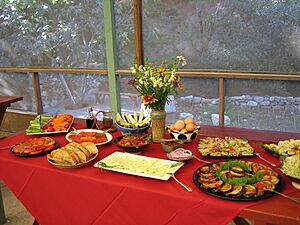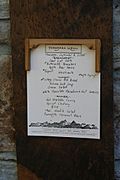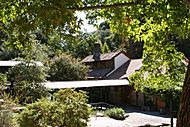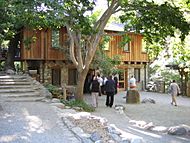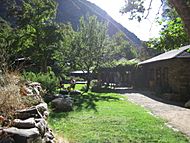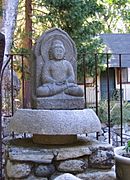Tassajara Zen Mountain Center facts for kids
Quick facts for kids Tassajara Zen Mountain Center |
|
|---|---|

Zendo at Tassajara
|
|
| Religion | |
| Affiliation | Buddhism |
| Sect | Soto Zen |
| Location | |
| Location | 39171 Tassajara Road Carmel Valley, CA 93924 |
| Country | United States |
| Architecture | |
| Founder | Shunryu Suzuki |
| Completed | 1967 |
| Website | |
| http://sfzc.org/tassajara/ | |
The Tassajara Zen Mountain Center is a special place in California. It is the oldest Zen monastery in the United States. A monastery is a place where people live and study their religion. Tassajara is located in a beautiful, wild area near Carmel-by-the-Sea, California. It is surrounded by the Los Padres National Forest.
Getting to Tassajara is an adventure! You have to drive on a narrow, steep, one-lane dirt road. This road goes over a mountain ridge that is over 5,000 feet high. Sometimes, in winter, the center can be hard to reach because of snow or heavy rain. People who live and study at Tassajara are called practitioners. They live there all year round. During the summer, from late May to early September, Tassajara welcomes guests. It has natural hot springs that have been made into Japanese-style baths. There is even a steam bath built over a hot spring! Tassajara was the first Zen monastery ever built outside of Asia.
Contents
History of Tassajara
What's in a Name?
The name "Tassajara" comes from an old word. It is a changed version of "Tasajera." This word came from the Esselen language of the native people who lived there. It means "place where meat is hung to dry."
Founding the Center
The land where Tassajara is located is 126 acres. The San Francisco Zen Center bought this land in 1967. They bought it from Robert and Anna Beck. After buying the land, they made many improvements. They renamed it The Tassajara Zen Mountain Center. It is also called Zenshinji, which means "Zen Mind Temple." Shunryu Suzuki was the first leader, or abbot, of the center. When it opened in 1967, it was the first Zen monastery outside of Asia.
Protecting Tassajara from Wildfires
Tassajara is in a remote area of California. This means it is often at risk from wildfires. In 2008, a big fire called the Basin Complex Fire reached the monastery. Five monks bravely stayed behind, even though others had to leave. They worked hard and successfully protected the center from the fire.
After this event, the San Francisco Zen Center created a special group. They trained firefighters to protect their three monasteries. These people are sometimes called "fire monks." The center also put in a special sprinkler system on its buildings. They call this system "dharma rain." In 2016, the Soberanes Fire threatened Tassajara. The center was not damaged, but it had to close to guests for the rest of the year. More recently, in June 2021, the Willow Fire also came close to the monastery.
Life at Tassajara
Practice Periods
During the fall (September to December) and spring (January to April), Tassajara has "practice periods." These are times of intense monastic study and practice. During these months, Tassajara is closed to the public. The daily schedule is very strict. People spend their time doing meditation (called zazen), studying, and working.
Guest Season
After the practice periods, Tassajara opens its doors to the public. This "guest season" runs from mid-April through early September. During this time, the daily schedule is less strict. The guest season is very important for Tassajara. It helps the center earn money to keep running.
The guest program includes a large kitchen operation. Tassajara is famous for its delicious vegetarian food. People from Tassajara also helped start other well-known food places. These include the Tassajara Bakery in San Francisco and Greens Restaurant at Fort Mason. Edward Espe Brown wrote a famous book called Tassajara Bread Book in 1970. This book helped make homemade bread very popular in the United States. He also wrote the Tassajara Recipe Book, which is one of several vegetarian cookbooks from people connected to the center.
Gallery
See also
- American Zen Teachers Association
- Soto Zen Buddhist Association
- Retreat (spiritual)
- Timeline of Zen Buddhism in the United States
- Glossary of Japanese Buddhism


